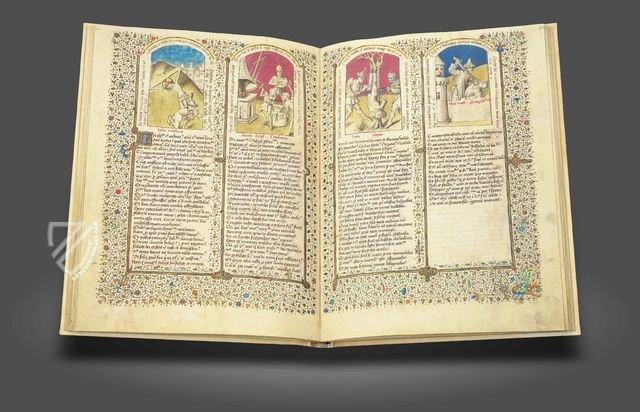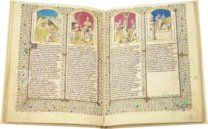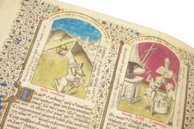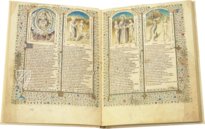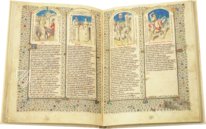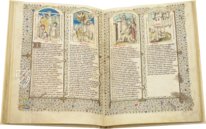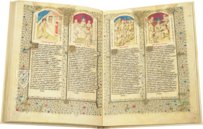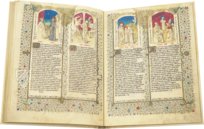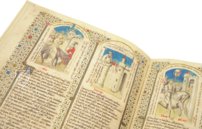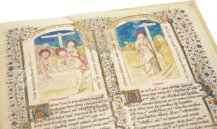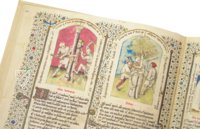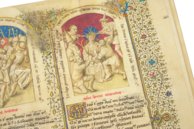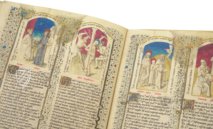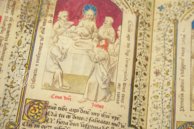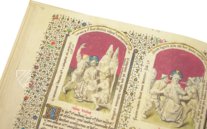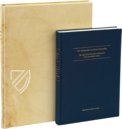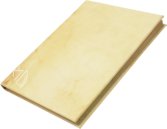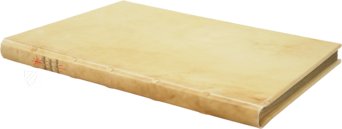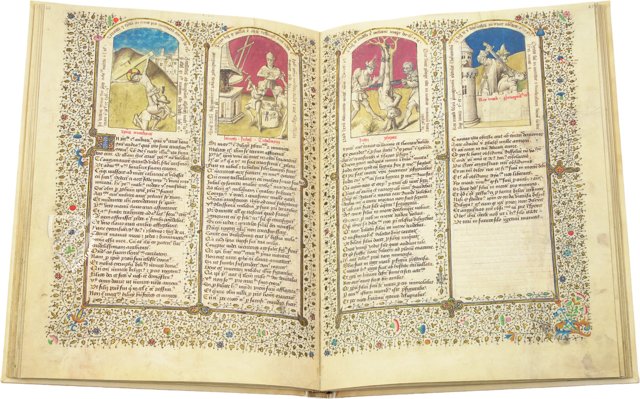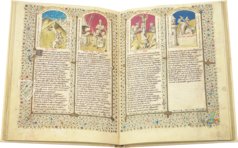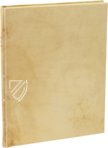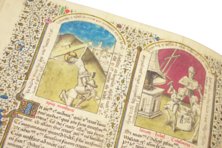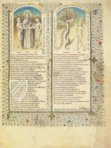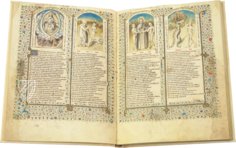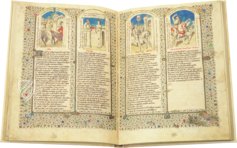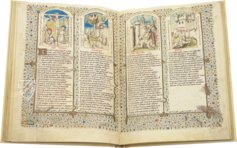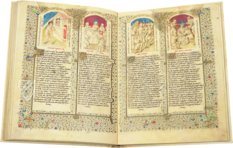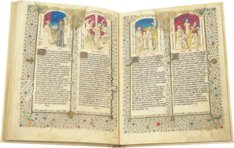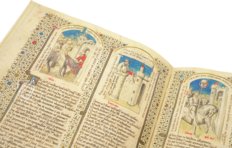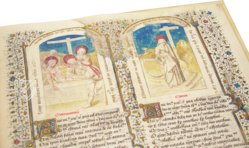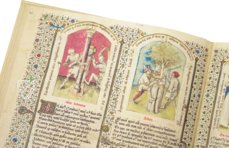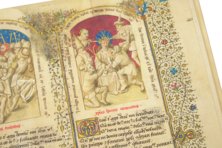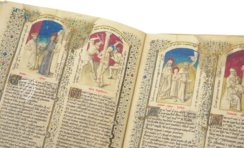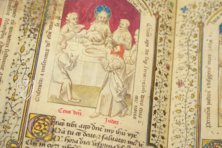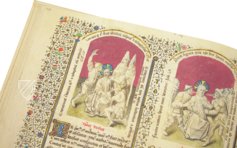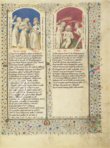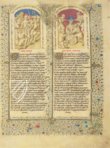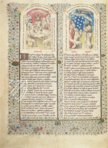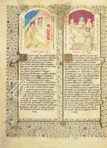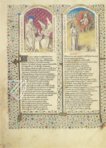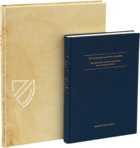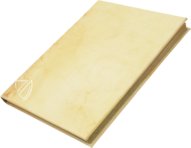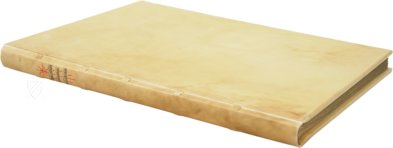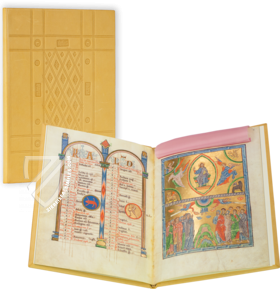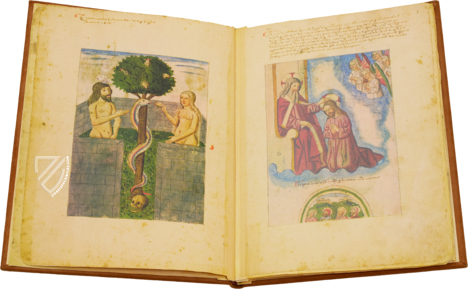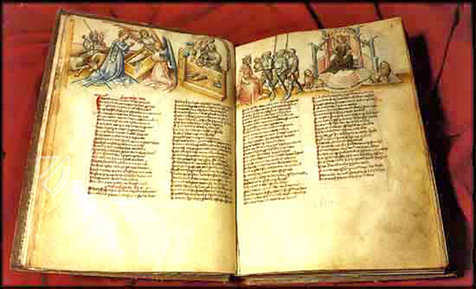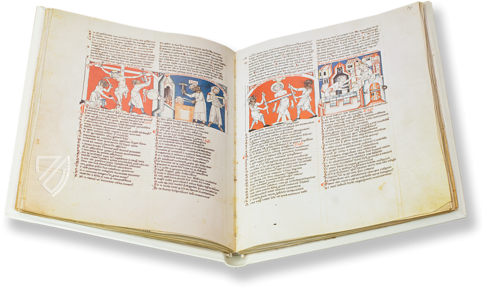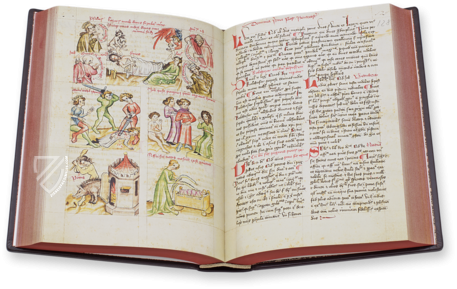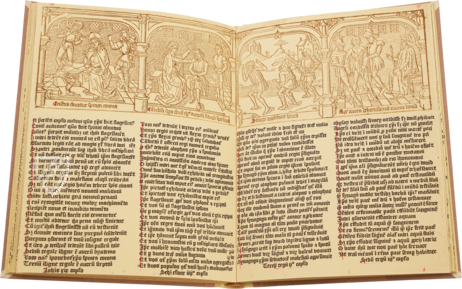Speculum Humanae Salvationis from Einsiedeln Abbey
(3,000€ - 7,000€)
The Speculum Humanae Salvationis from Einsiedeln Abbey originates from between 1450 and 1460 in the Burgundian Netherlands. The codex produces the salvation-history connection between the events of the New and Old Testaments and is unusually richly decorated with colored illustrations and golden décor elements.
Speculum Humanae Salvationis from Einsiedeln Abbey
Since the Late Middle Ages, Speculae Humanae Salvationis or Mirrors of Human Salvation are a widespread form of Christian devotional books that illustrate the salvation history to the laity. Probably the most valuable medieval Speculum Humanae Salvationis originates from between 1450 and 1460, most likely in the Burgundian Netherlands. This codex is known as the Speculum Humanae Salvationis from Einsiedeln Abbey. The work contains 92 pages with 176 vividly illustrated miniatures, which depict the biblical events of the Old and New Testaments from the Fall of Man to the Day of Judgement. In word and picture, the stories intertwines the stories into a continuous, purposeful narrative.
A Master from the Highest Circles
A book illuminator whose name is no longer known was responsible for the astounding Speculum Humanae Salvationis. It is suspected that it was an artist, who was occasionally employed by the royal notary and secretary of Dreux Budé in France. Therefore, the master must have been someone who moved in the highest circles of the nobility. His style and skill show that he was acquainted with the painting of Rogier van der Weydens and was also influenced by the Books of Hours of the popular masters of Boucicaut in his own work.
The Christian Worldview of an Entire Epoch
The Speculum Humanae Salvationis would have been read by both clerics and the educated laity. Every event of the New Testament was accompanied by an event of the Old Testament that forebode it. The production of a nexus between the both Testaments was distinctive of the whole worldview of Christians in the Middle Ages. The promise, which was given to the people of Israel, was fulfilled through the salvation of mankind by Jesus Christ. This worldview was **supported by picture books oriented on salvation history.
Highly Detailed and Lively Depictions
The 176 pen and ink drawings are held in delicate pastel tones. They show not only biblical scenes but also depict everyday scenes from medieval life in great detail. The painter relocates the beholder back to medieval cities with imposing gates, knights and craftsmen who people the streets, as well as temples, wells, and forges. No limits were set on the imagination of the artist. The depictions of human figures, which are surprisingly vivid with draped garments and hatched shadows are especially well depicted. On every double-page four miniatures are to be found that are described through text passages.
A Special Technique
The page margins of the Speculum Humanae Salvationis are decorated with an elaborate décor of thorny leaves in gold. The text is embellished with 57 three-line decorated initials on a gold background. This is extremely unusual for a Speculum Humanae Salvationis, which are normally humble and decorated less ostentatiously. The application of gold leaf makes the codex one of the most costly works of its type and gives almost unending suggestions for further illuminated manuscripts, for example, the beloved and widely circulated Books of Hours.
Codicology
- Alternative Titles
- Speculum Humanae Salvationis
Heilsspiegel aus Kloster Einsiedeln
Miroir de l'humaine salvation de l'abbaye d'Einsiedeln - Size / Format
- 92 pages / 36.2 × 27.5 cm
- Origin
- France
- Date
- Around 1430–1450
- Epochs
- Style
- Genre
- Language
- Illustrations
- 176 miniatures
- Artist / School
- Style of Rogier van der Weyden and Boucicaut Master
- Previous Owners
- Master of Dreux Budé
Speculum Humanae Salvationis from Einsiedeln Abbey
Judas Receives the Eucharist
Aside from being differentiated from the other Apostles with red hair and a beard, Judas is also labelled in this miniature showing him receive the Eucharist from Jesus, who has a blue and gold cross-halo. Judas’ feet stick out from the frame, a nod to the fact that he immediately departed from the supper after receiving the piece of bread. According to the Gospel of John, Satan entered Judas the moment he ate the bread, propelling him to betray Jesus.
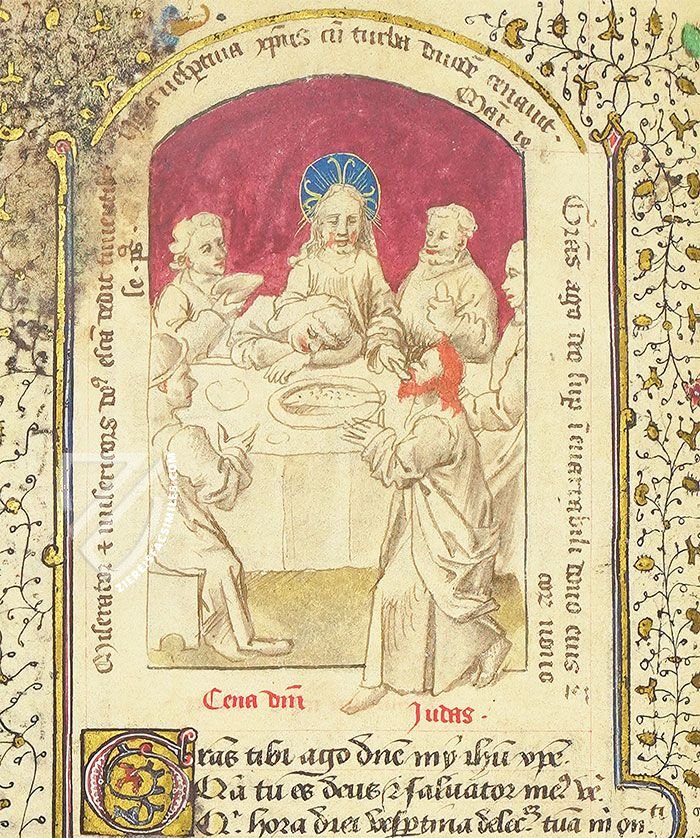
Speculum Humanae Salvationis from Einsiedeln Abbey
Christ’s Birth and the Cup-bearer’s Dream
This is a fine example of the illumination found in the manuscript at hand, which is filled with frames consisting of golden filigree tendrils and colorful flowers. By contrast, the color palette of the miniatures is reduced to just blue and grey tones, highlighting the artist’s skilled pen strokes. Franco-Dutch Gothic architecture in the background indicates the manuscript’s origins.
This genre presents the history of salvation in a series of juxtaposed scenes from the Old and New Testaments. In the Book of Genesis, the Pharaoh’s cup-bearer has a dream about a vine with three budding branches. Although Joseph interprets the dream as indicating that the cup-bearer will be restored to Pharaoh’s favor, it also prophesizes the Holy Trinity.
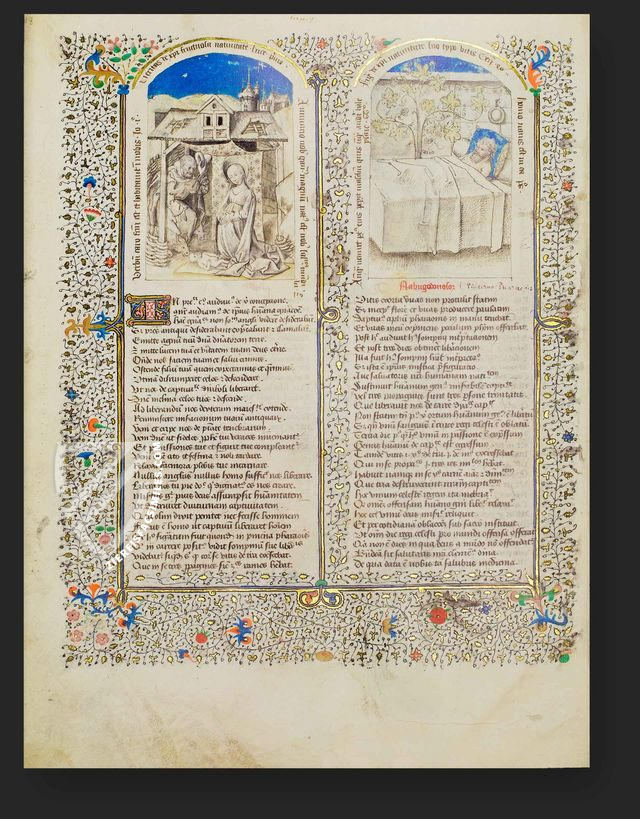
#1 Heilsspiegel aus Kloster Einsiedeln
Languages: English, German
(3,000€ - 7,000€)
- Treatises / Secular Books
- Apocalypses / Beatus
- Astronomy / Astrology
- Bestiaries
- Bibles / Gospels
- Chronicles / History / Law
- Geography / Maps
- Saints' Lives
- Islam / Oriental
- Judaism / Hebrew
- Single Leaf Collections
- Leonardo da Vinci
- Literature / Poetry
- Liturgical Manuscripts
- Medicine / Botany / Alchemy
- Music
- Mythology / Prophecies
- Psalters
- Other Religious Books
- Games / Hunting
- Private Devotion Books
- Other Genres
- Afghanistan
- Armenia
- Austria
- Belgium
- Belize
- Bosnia and Herzegovina
- China
- Colombia
- Costa Rica
- Croatia
- Cyprus
- Czech Republic
- Denmark
- Egypt
- El Salvador
- Ethiopia
- France
- Germany
- Greece
- Guatemala
- Honduras
- Hungary
- India
- Iran
- Iraq
- Israel
- Italy
- Japan
- Jordan
- Kazakhstan
- Kyrgyzstan
- Lebanon
- Liechtenstein
- Luxembourg
- Mexico
- Morocco
- Netherlands
- Palestine
- Panama
- Peru
- Poland
- Portugal
- Romania
- Russia
- Serbia
- Spain
- Sri Lanka
- Sweden
- Switzerland
- Syria
- Tajikistan
- Turkey
- Turkmenistan
- Ukraine
- United Kingdom
- United States
- Uzbekistan
- Vatican City
- A. Oosthoek, van Holkema & Warendorf
- Aboca Museum
- Ajuntament de Valencia
- Akademie Verlag
- Akademische Druck- u. Verlagsanstalt (ADEVA)
- Aldo Ausilio Editore - Bottega d’Erasmo
- Alecto Historical Editions
- Alkuin Verlag
- Almqvist & Wiksell
- Amilcare Pizzi
- Andreas & Andreas Verlagsbuchhandlung
- Archa 90
- Archiv Verlag
- Archivi Edizioni
- Arnold Verlag
- ARS
- Ars Magna
- ArtCodex
- AyN Ediciones
- Azimuth Editions
- Badenia Verlag
- Bärenreiter-Verlag
- Belser Verlag
- Belser Verlag / WK Wertkontor
- Benziger Verlag
- Bernardinum Wydawnictwo
- BiblioGemma
- Biblioteca Apostolica Vaticana (Vaticanstadt, Vaticanstadt)
- Bibliotheca Palatina Faksimile Verlag
- Bibliotheca Rara
- Boydell & Brewer
- Bramante Edizioni
- Bredius Genootschap
- Brepols Publishers
- British Library
- C. Weckesser
- Caixa Catalunya
- Canesi
- CAPSA, Ars Scriptoria
- Caratzas Brothers, Publishers
- Carus Verlag
- Casamassima Libri
- Centrum Cartographie Verlag GmbH
- Chavane Verlag
- Christian Brandstätter Verlag
- Circulo Cientifico
- Club Bibliófilo Versol
- Club du Livre
- CM Editores
- Collegium Graphicum
- Collezione Apocrifa Da Vinci
- Comissão Nacional para as Comemorações dos Descobrimentos Portugueses
- Coron Verlag
- Corvina
- CTHS
- D. S. Brewer
- Damon
- De Agostini/UTET
- De Nederlandsche Boekhandel
- De Schutter
- Deuschle & Stemmle
- Deutscher Verlag für Kunstwissenschaft
- DIAMM
- Droz
- E. Schreiber Graphische Kunstanstalten
- Ediciones Boreal
- Ediciones Grial
- Ediclube
- Edições Inapa
- Edilan
- Editalia
- Edition Deuschle
- Edition Georg Popp
- Edition Leipzig
- Edition Libri Illustri
- Editiones Reales Sitios S. L.
- Éditions de l'Oiseau Lyre
- Editions Medicina Rara
- Editorial Casariego
- Editorial Mintzoa
- Editrice Antenore
- Editrice Velar
- Edizioni Edison
- Egeria, S.L.
- Eikon Editores
- Electa
- Emery Walker Limited
- Enciclopèdia Catalana
- Eos-Verlag
- Ephesus Publishing
- Ernst Battenberg
- Eugrammia Press
- Extraordinary Editions
- Fackelverlag
- Facsimila Art & Edition
- Facsimile Editions Ltd.
- Facsimilia Art & Edition Ebert KG
- Faksimile Verlag
- Feuermann Verlag
- Folger Shakespeare Library
- Franco Cosimo Panini Editore
- Friedrich Wittig Verlag
- Fundación Hullera Vasco-Leonesa
- G. Braziller
- Gabriele Mazzotta Editore
- Gebr. Mann Verlag
- Gesellschaft für graphische Industrie
- Getty Research Institute
- Giovanni Domenico de Rossi
- Giunti Editore
- Graffiti
- Grafica European Center of Fine Arts
- Guido Pressler
- Guillermo Blazquez
- Gustav Kiepenheuer
- H. N. Abrams
- Harrassowitz
- Harvard University Press
- Helikon
- Hendrickson Publishers
- Henning Oppermann
- Herder Verlag
- Hes & De Graaf Publishers
- Hoepli
- Holbein-Verlag
- Houghton Library
- Hugo Schmidt Verlag
- Idion Verlag
- Il Bulino, edizioni d'arte
- ILte
- Imago
- Insel Verlag
- Insel-Verlag Anton Kippenberger
- Instituto de Estudios Altoaragoneses
- Instituto Nacional de Antropología e Historia
- Introligatornia Budnik Jerzy
- Istituto dell'Enciclopedia Italiana - Treccani
- Istituto Ellenico di Studi Bizantini e Postbizantini
- Istituto Geografico De Agostini
- Istituto Poligrafico e Zecca dello Stato
- Italarte Art Establishments
- Jan Thorbecke Verlag
- Johnson Reprint Corporation
- Josef Stocker
- Josef Stocker-Schmid
- Jugoslavija
- Karl W. Hiersemann
- Kasper Straube
- Kaydeda Ediciones
- Kindler Verlag / Coron Verlag
- Kodansha International Ltd.
- Konrad Kölbl Verlag
- Kurt Wolff Verlag
- La Liberia dello Stato
- La Linea Editrice
- La Meta Editore
- Lambert Schneider
- Landeskreditbank Baden-Württemberg
- Leo S. Olschki
- Les Incunables
- Liber Artis
- Library of Congress
- Libreria Musicale Italiana
- Lichtdruck
- Lito Immagine Editore
- Lumen Artis
- Lund Humphries
- M. Moleiro Editor
- Maison des Sciences de l'homme et de la société de Poitiers
- Manuscriptum
- Martinus Nijhoff
- Maruzen-Yushodo Co. Ltd.
- MASA
- Massada Publishers
- McGraw-Hill
- Metropolitan Museum of Art
- Militos
- Millennium Liber
- Müller & Schindler
- Nahar - Stavit
- Nahar and Steimatzky
- National Library of Wales
- Neri Pozza
- Nova Charta
- Oceanum Verlag
- Odeon
- Orbis Mediaevalis
- Orbis Pictus
- Österreichische Staatsdruckerei
- Oxford University Press
- Pageant Books
- Parzellers Buchverlag
- Patrimonio Ediciones
- Pattloch Verlag
- PIAF
- Pieper Verlag
- Plon-Nourrit et cie
- Poligrafiche Bolis
- Presses Universitaires de Strasbourg
- Prestel Verlag
- Princeton University Press
- Prisma Verlag
- Priuli & Verlucca, editori
- Pro Sport Verlag
- Propyläen Verlag
- Pytheas Books
- Quaternio Verlag Luzern
- Reales Sitios
- Recht-Verlag
- Reichert Verlag
- Reichsdruckerei
- Reprint Verlag
- Riehn & Reusch
- Roberto Vattori Editore
- Rosenkilde and Bagger
- Roxburghe Club
- Salerno Editrice
- Saltellus Press
- Sandoz
- Sarajevo Svjetlost
- Schöck ArtPrint Kft.
- Schulsinger Brothers
- Scolar Press
- Scrinium
- Scripta Maneant
- Scriptorium
- Shazar
- Siloé, arte y bibliofilia
- SISMEL - Edizioni del Galluzzo
- Sociedad Mexicana de Antropología
- Société des Bibliophiles & Iconophiles de Belgique
- Soncin Publishing
- Sorli Ediciones
- Stainer and Bell
- Studer
- Styria Verlag
- Sumptibus Pragopress
- Szegedi Tudomànyegyetem
- Taberna Libraria
- Tarshish Books
- Taschen
- Tempus Libri
- Testimonio Compañía Editorial
- Thames and Hudson
- The Clear Vue Publishing Partnership Limited
- The Facsimile Codex
- The Folio Society
- The Marquess of Normanby
- The Richard III and Yorkist History Trust
- Tip.Le.Co
- TouchArt
- TREC Publishing House
- TRI Publishing Co.
- Trident Editore
- Tuliba Collection
- Typis Regiae Officinae Polygraphicae
- Union Verlag Berlin
- Universidad de Granada
- University of California Press
- University of Chicago Press
- Urs Graf
- Vallecchi
- Van Wijnen
- VCH, Acta Humaniora
- VDI Verlag
- VEB Deutscher Verlag für Musik
- Verlag Anton Pustet / Andreas Verlag
- Verlag Bibliophile Drucke Josef Stocker
- Verlag der Münchner Drucke
- Verlag für Regionalgeschichte
- Verlag Styria
- Vicent Garcia Editores
- W. Turnowski Ltd.
- W. Turnowsky
- Waanders Printers
- Wiener Mechitharisten-Congregation (Wien, Österreich)
- Wissenschaftliche Buchgesellschaft
- Wissenschaftliche Verlagsgesellschaft
- Wydawnictwo Dolnoslaskie
- Xuntanza Editorial
- Zakład Narodowy
- Zollikofer AG

